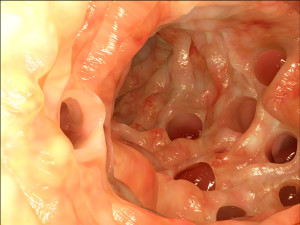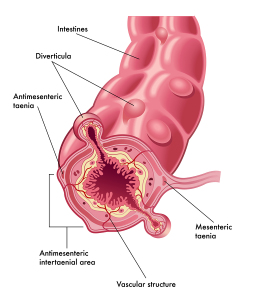Introduction
Diverticular disease, also known as diverticulosis is a large intestinal disease where pockets form that can get infected and abscessed.
The colon normally has muscle fibers everywhere in the wall of the large intestine. However, with chronic constipation and a low fiber diet over many years the intraluminal pressure in the colon is too high leading to a pouching out at the weakest point of the bowel wall.
Formation of diverticulum
It is like a mini-hernia and the lining of the colon herniates through a hole in the muscle layer of the colon. This is the beginning of a diverticulum, which normally is 1/4 to 1/2 inch in diameter. When many diverticles have developed, the condition is called “diverticulosis”or “diverticular disease”. This is an abnormal condition, but is still considered to be normal in the person aged 40 or older. In a 90 year old person there are usually many diverticles present. Fortunately, with a reasonable fiber rich diet diverticulosis is not even noticed. However, two complications can occur.
Symptoms
There can be sudden bleeding from a diverticle (seen as rectal bleeding) because of irritation from a piece of old stool that may have been caught in it. If the bleeding is more than 1ml per minute, a special procedure may have to be done, where an arterial catheter is introduced into the main leg artery. Through the catheter the cardiologist can identify the bleeder and inject a substance, which contracts the blood vessel and in about 70% of patients this will stop the bleeding. The surgeon will likely recommend removal of the diseased segment of colon by way of a segmental colon resection. The other complication is a colon perforation of such a diverticle and this would lead to an acute abdomen with resulting peritonitis due to the extreme load of bacteria from, the colon with E.coli and anaerobe bacteria.
Treatment
This requires usually a two stage procedure with initial laparotomy, oversewing of the perforation and a colostomy (artificial opening of the proximal colon to the skin). At a later stage the segmental colon resection would be done with an anastomosis of the colon (end-to-end) and a colostomy reversal.
References
1. M Frevel Aliment Pharmacol Ther 2000 Sep (9): 1151-1157.
2. M Candelli et al. Panminerva Med 2000 Mar 42(1): 55-59.
3. LA Thomas et al. Gastroenterology 2000 Sep 119(3): 806-815.
4. R Tritapepe et al. Panminerva Med 1999 Sep 41(3): 243-246.
5. The Merck Manual, 7th edition, by M. H. Beers et al., Whitehouse Station, N.J., 1999. Chapters 20,23, 26.
6. EJ Simchuk et al. Am J Surg 2000 May 179(5):352-355.
7. G Uomo et al. Ann Ital Chir 2000 Jan/Feb 71(1): 17-21.
8. PG Lankisch et al. Int J Pancreatol 1999 Dec 26(3): 131-136.
9. HB Cook et al. J Gastroenterol Hepatol 2000 Sep 15(9): 1032-1036.
10. W Dickey et al. Am J Gastroenterol 2000 March 95(3): 712-714.
11. M Hummel et al. Diabetologia 2000 Aug 43(8): 1005-1011.
12. DG Bowen et al. Dig Dis Sci 2000 Sep 45(9):1810-1813.
13. The Merck Manual, 7th edition, by M. H. Beers et al., Whitehouse Station, N.J., 1999.Chapter 31, page 311.
14. O Punyabati et al. Indian J Gastroenterol 2000 Jul/Sep 19(3):122-125.
15. S Blomhoff et al. Dig Dis Sci 2000 Jun 45(6): 1160-1165.
16. M Camilleri et al. J Am Geriatr Soc 2000 Sep 48(9):1142-1150.
More references
17. MJ Smith et al. J R Coll Physicians Lond 2000 Sep/Oct 34(5): 448-451.
18. YA Saito et al. Am J Gastroenterol 2000 Oct 95(10): 2816-2824.
19. M Camilleri Am J Med 1999 Nov 107(5A): 27S-32S.
20. CM Prather et al. Gastroenterology 2000 Mar 118(3): 463-468.
21. MJ Farthing : Baillieres Best Pract Res Clin Gastroenterol 1999 Oct 13(3): 461-471.
22. D Heresbach et al. Eur Cytokine Netw 1999 Mar 10(1): 7-15.
23. BE Sands et al. Gastroenterology 1999 Jul 117(1):58-64.
24. B Greenwood-Van Meerveld et al.Lab invest 2000 Aug 80(8):1269-1280.
25. GR Hill et al. Blood 2000 May 1;95(9): 2754-2759.
26. RB Stein et al. Drug Saf 2000 Nov 23(5):429-448.
27. JM Wagner et al. JAMA 1996 Nov 20;276 (19): 1589-1594.
28. James Chin, M.D. Control of Communicable Diseases Manual. 17th ed., American Public Health Association, 2000.
29. The Merck Manual, 7th edition, by M. H. Beers et al., Whitehouse Station, N.J., 1999. Chapter 157, page1181.
30. Textbook of Primary Care Medicine, 3rd ed., Copyright © 2001 Mosby, Inc., pages 976-983: “Chapter 107 – Acute Abdomen and Common Surgical Abdominal Problems”.
31. Marx: Rosen’s Emergency Medicine: Concepts and Clinical Practice, 5th ed., Copyright © 2002 Mosby, Inc. , p. 185:”Abdominal pain”.
32. Feldman: Sleisenger & Fordtran’s Gastrointestinal and Liver Disease, 7th ed., Copyright © 2002 Elsevier, p. 71: “Chapter 4 – Abdominal Pain, Including the Acute Abdomen”.
33. Ferri: Ferri’s Clinical Advisor: Instant Diagnosis and Treatment, 2004 ed., Copyright © 2004 Mosby, Inc








